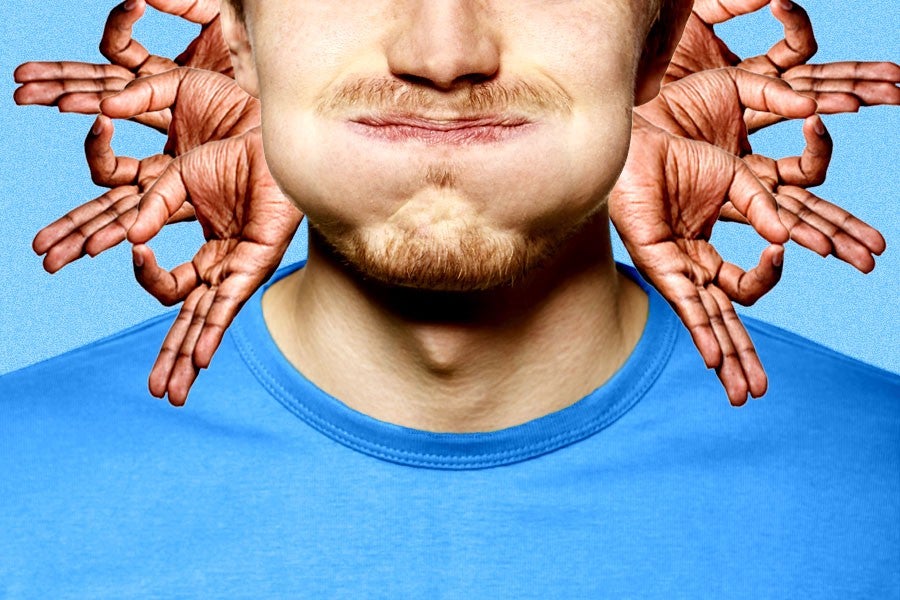“Whew! I’m tired!” Japanese anti-aging guru Koko Hayashi exclaims over Skype approximately 25 minutes into our 50-minute private face yoga session.
While I’m personally not winded by any means, my face is admittedly strained. Hayashi, founder and certified face yoga instructor at Skin Fit Gym in L.A., has efficiently guided me through facial exercise after facial exercise: Combat Stress; Lip Vibration; Anti-Gobble Neck; The Nasolabial Folds Lift Up; The Yummy Face; Lip Sumo (aka, Kylie Jenner Lips); No Mouth; Smile Line Ironing; and Anti-Bulldog Face.
According to Hayashi, these exercises are designed to reduce wrinkles and prevent sagging by honing otherwise sedentary facial muscles. “The idea behind face yoga is to wake up those sleeping muscles,” she says, referring to her claim that everyday facial movements like chewing, frowning and smiling consistently exercise only 20 percent of the 43 muscles in the face.
While I’m skeptical — our session feels less like yoga, and more like the World Gurning Championships/a warehouse rave some time in the mid-1990s — there’s some science corroborating her claims: A recent study published in the peer-reviewed medical journal JAMA Dermatology found that middle-aged women looked approximately three years younger after performing facial exercises for only a few months.
Naturally, some medical experts disagree. For instance, leading facial plastic surgeon Jeffrey Spiegel argues that facial yoga actually exacerbates facial aging by constantly stretching and wrinkling the face. (Of course, it should be noted that a plastic surgeon may have ulterior motives here, especially when they conclude with a plug like, “Try thinking about Botox injections if you truly want to reduce wrinkles in the face.”)
Either way, there’s no denying that face yoga is becoming increasingly trendy. Over the last few years, FaceGym in London and FaceLove in New York City have incorporated facial exercises into their treatments. Hayashi adds that face yoga has long been popular in Japan — the Japanese face yoga studio where she began her career purportedly employs more than 600 instructors.
A Deep-Seated Gurning
But back to my yoga lesson. Before beginning the actual facial exercises, Hayashi recommends we relax our face muscles by engaging in laughter yoga, a practice involving voluntary laughter. We force ourselves to laugh for 30 extremely awkward seconds, after which I feel increasingly less relaxed (and a little self-conscious).
We breeze through a few quick warm-ups — one of which involves blowing a raspberry — and Hayashi teaches me a couple of neck exercises, which allegedly reduce sagging and prevent “text neck.” After spending the majority of my morning with my head tilted down toward my computer, leaning my head back while pointing my tongue at the sun provides a much-needed stretch.
Next, Hayashi guides me through a series of cheekbone exercises. “Some Hollywood stars put implants in their cheeks,” she says. “We don’t have to do that with these exercises.” All the while, my face is utterly distorted — my cheeks are raised, my lips are curled, my eyes are beaming and my forehead is stretched. At this point, I’m uncomfortably attempting to engage muscles I never knew existed.
We continue with what Hayashi calls the “Kylie Jenner Lips” exercise. “Kylie Jenner has fuller lips,” she tells me. “But we don’t want to do injections, because they’re painful; we want to do these exercises instead.” I forcefully press my upper and lower lips together without allowing my teeth to touch.
For the sake of time, Hayashi encourages me to move onto another exercise designed to reduce my smile line, i.e., the wrinkles that tend to develop around the sides of the mouth. This exercise is relatively simple: I use my tongue to massage the inside of my mouth, directly underneath the smile lines. At this point, my face muscles (including my tongue) are slightly fatigued. Hayashi apparently shares this sentiment: “Sometimes I push myself very hard and become a little bit faint,” she says.
Nonetheless, we bravely continue to make silly faces at each other.
Hayashi encourages me to attempt the “Lower Eyelid Lift Up,” which involves (you guessed it) using your face muscles to lift only your lower eyelids. While this may seem straightforward, it’s incredibly difficult — I immediately realize I have almost no control over the muscles sitting directly under my eyes.
After a few failed attempts, we perform a brief forehead exercise, which involves performing various facial movements without furrowing your brow. At this point, Hayashi insists that the majority of these exercises should be executed without wrinkling the face, as that will only cause more wrinkles.
Hayashi concludes our session by teaching me two facial stretches. The first involves lifting and stretching each cheekbone with the help of your hands, which supposedly makes the face more symmetrical. The second — which is essentially — is meant to reduce wrinkles. “Because we cause wrinkles during some of these exercises, we need to stretch the face so that those wrinkles don’t remain,” Hayashi explains. This seems reasonable, so we do just that, and Hayashi once again tells me, “I’m tired!”
Facing the Consequences
As far as I can tell, when it’s all over, I don’t have a noticeably firmer face (although my colleague C. Brian Smith seemed to believe otherwise after I told him about my session). But then, real results purportedly require weeks or even months of regular training — Hayashi says that results are generally visible only after weeks of performing daily facial exercises.
While I didn’t wake up feeling sore the next day, I did feel like I was exercising my face muscles throughout the session, which at least partly convinced me that constantly practicing face yoga may really tone your face.
Then again, will I ever practice face yoga of my own volition? Probably not. But that’s only because attempting to lick my eyebrows in the hopes of reducing wrinkles simply isn’t something I trust myself to do on a regular basis.
My loss.

